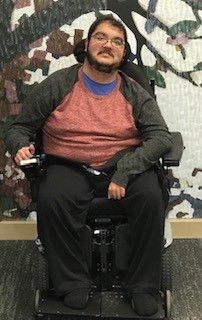 A blog post by Sumukha Terakanambi, MCD Public Policy Consultant
A blog post by Sumukha Terakanambi, MCD Public Policy Consultant
For years, Uber and Lyft have provided millions of Americans with convenient, on-demand transportation. With a few taps of the phone, people can request a ride, and a car shows up at their location in minutes. Technology like this can give people with disabilities greater independence in their communities. Lyft demonstrated how this could work when they partnered with Dakota County to provide a waivered transportation option for people traveling to and from their jobs.
Despite such efforts, people in wheelchairs are still excluded from the promise of convenient, on-demand transportation.
Currently, very few on-demand accessible options exist for people in wheelchairs. Metro Mobility and private transportation providers require individuals to book rides days ahead of time. Some taxis offer wheelchair-accessible vehicles, but services may not always be available. As a result, people in wheelchairs lose their independence and miss out on spontaneous activities happening in the community. They also struggle to get to their jobs, run important errands throughout the day, and, most importantly, are left without transportation options in emergencies.
As a person with Muscular Dystrophy who relies on a power wheelchair for mobility, I am intimately familiar with these challenges. Just a month ago, I found myself in a dire situation when my wheelchair-accessible van broke down at my local Sports Clips. What should have been a quick 20-minute haircut turned into a three-hour ordeal. One of the van’s doors had jammed, preventing the wheelchair ramp from releasing. Despite my dad’s best efforts, the door remained stuck. Panic set in as I contemplated the possibility of being stranded. How would I get home if the van couldn’t be fixed immediately?
After a few minutes, my dad called Metro Mobility to see if they could drop me off at home while he got the van fixed. Unfortunately, the person he spoke with was incredibly unsympathetic to my situation and refused to make an exception for this emergency. To make matters worse, it was too cold to walk home, and we were too far away from public transportation. Left with no other options, my dad called a tow truck and had the van towed to a mechanic. In the meantime, I was stranded at Sports Clips.
When situations like this occur, most individuals can immediately book an Uber or Lyft and get back to their home or workplace. But there I was, anxiously waiting for an update about the van. The delay also prevented me from attending important meetings and completing other work-related tasks. Luckily, my brother could come and wait with me until the van was fixed. Although the situation could have been much worse, it made me think about the potential risks to my health and well-being. What would have happened if I had not been able to wait inside and the van could not have been repaired the same day?
My story illustrates the significant impact that a lack of on-demand wheelchair-accessible options is having on people like me who use wheelchairs for mobility. The lack of transportation options is denying us the ability to maintain employment, be independent, and participate in the community without having to plan way ahead of time. It also presents a gap in transportation services that could cause significant safety threats to people with disabilities, especially during winter.
Convenience and freedom should be for everyone, including people in wheelchairs. That is why Uber and Lyft must be required to provide wheelchair accessible vans for Minnesota to be a more inclusive state.